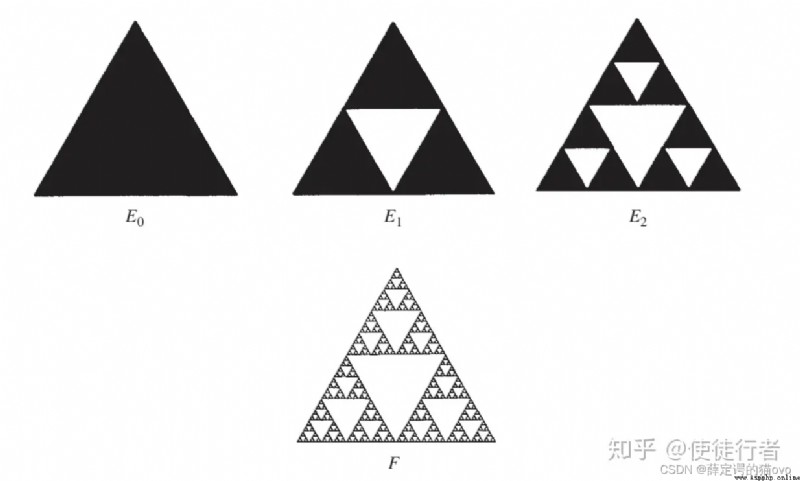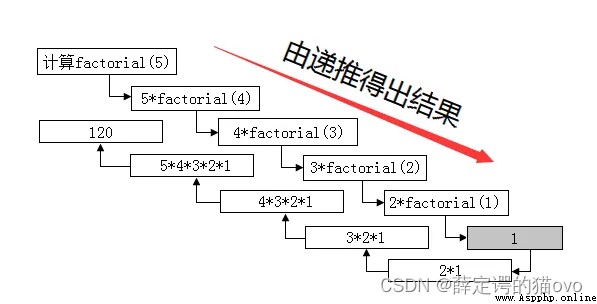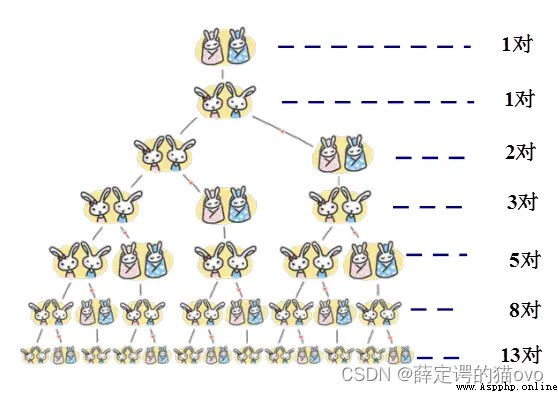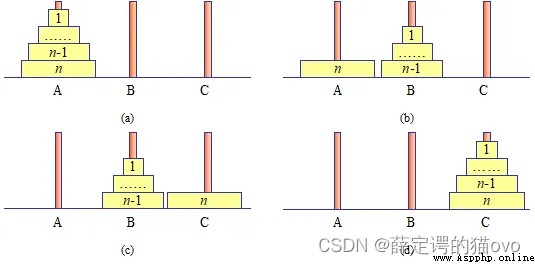recursive , In principle , Namely Functions directly or indirectly call their own algorithms . Is to repeatedly call the function itself to realize the loop , When the termination conditions are met, the end loop is returned layer by layer , Is an algorithm structure .
There are many examples of recursion in everyday programming , For example, the scherpinsky triangle :

The factorial of a positive integer is from 1 multiply 2 multiply 3 multiply 4 Until the required number . for example , The number required is 5 The factorial , Then the factorial is 1×2×3×4×5, The product we get is 120, therefore 120 Namely 5 The factorial .
Non recursive version :
# Calculate the factorial ( Non recursive )def recrusion(n): result = n for i in range(1, n): result *= i return resultnumber = int(input(' Please enter an integer :'))result = recrusion(number)print("%d The factorial is :%d" % (number, result))The results are as follows :

Recursive version :
# Calculate the factorial ( recursive )def recrusion(n): if n == 1: return 1 else: return n*recrusion(n-1)number = int(input(' Please enter an integer :'))result = recrusion(number)print("%d The factorial is :%d" % (number, result))The implementation result is :

The detailed analysis of the implementation of recursive functions is shown in the following figure :

This example satisfies Two conditions of recursion :
(1) Call the function itself
(2) Set the correct return condition
Another classic example of recursion —— Fibonacci sequence . The inventor of Fibonacci series , It's the Italian mathematician Leonardo · Fibonacci (Leonardo Fibonacci). The general description is as follows :
If there is a pair of newborn rabbits , It only takes a month for a small rabbit to grow into a big rabbit , From the third month on , The big rabbits give birth to a pair of little rabbits every month . The new rabbit will spend another month growing up , Take another month to start giving birth to rabbits … in other words , Two months after the rabbit was born , It has the ability to reproduce , After having the ability to reproduce , This pair of rabbits can give birth to a pair of little rabbits every month , If every pair of rabbits were born like this 、 mature 、 The process of procreation , And never die , What is the total number of rabbits per month ?

Only in the first month 1 Yes, baby rabbit .
In the second month, only 1 Yes, big rabbit .
In the third month, the big rabbit gave birth to a pair of baby rabbits , One big one small 2 To the rabbit .
In the fourth month, the big rabbit continued to give birth to a pair of baby rabbits , The little rabbit becomes the big rabbit . Two big and one small 3 To the rabbit .
….
therefore , We can get the total number of rabbits per month :
It can be defined by mathematical functions :
Recursive implementation :
# Realization of Fibonacci series def fab(n): if n < 1: print(' Incorrect input !') return -1 if n == 1 or n == 2: return 1 else: return fab(n-1) + fab(n-2)result = fab(12)if result != -1: print(" The first 12 Months in total %d To the rabbit " % result) The implementation result is 144.
The logic of recursion is simple , however If recursion is not used properly , It's going to be inefficient . Because the implementation of recursion is that the function calls itself , Every time a function is called, you need to press the stack 、 Out of the stack 、 The operation of saving and restoring registers , So it's very time and space consuming up here .
French mathematician Edward · Lucas wrote an ancient Indian legend : In the center of the world, Benares ( In northern India ) In the holy temple of , There are three jewel needles on a brass plate . When Brahman, the Hindu God, created the world , On one of the pins, from bottom to top, from big to small 64 A piece of gold , This is the so-called Hanoi tower . Day and night , There's always a monk moving these gold pieces according to the following rules : Move only one piece at a time , No matter on which needle , Small pieces have to be on top of big ones . The monks prophesied , When all the gold pieces are moved from one needle that Brahman had put on to another , The world will be destroyed in a thunderbolt , And the vatta 、 Temples and all living beings will die together .
To solve this problem , The idea is as follows :
(1) Before the 63 A plate from A Move to B On , Make sure the market is under the small one .
(2) Put the bottom third 64 A plate from A Move to C On .
(3) take B Upper 63 The plates move to C On .

The idea of solving the problem has been improved , The key is the steps (1) And steps (3) How to execute . Because only one disc can be moved at a time , So in the process of moving , Obviously, it can only be implemented with the help of another needle . in other words , step (1) take 1~63 A plate needs help C Move to B On , step (3) take B Upper 63 With the help of A Move to C On .
therefore , Gather the new ideas into the following two questions :
Question 1 : take A Upper 63 With the help of C Move to B On ;
Question two : take B Upper 63 With the help of A Move to C On .
And the corresponding The solution to question 1 and question 2 is the same as the first question just now .
Question 1 ( take A Upper 63 With the help of C Move to B On ) It can be disassembled into :
(1) Before the 62 A plate from A Move to C On , Make sure the market is under the small market .
(2) Put the bottom third 63 The plates move to B On .
(3) take C Upper 62 The plates move to B On .
Question two ( take B Upper 63 With the help of A Move to C On ) It can be disassembled into :
(1) Before the 62 A plate from B Move to A On , Make sure the market is under the small market .
(2) Put the bottom third 63 The plates move to C On .
(3) take A Upper 62 The plates move to C On .
therefore , This problem can be solved by recursion :
# The hanotta problem def hanoi(n, a, b, c): # Will be the first n Layer from a With the help of b Move to c if n == 1: print(a, '-->', c) # If there is only one floor , Directly from a Move to c else: hanoi(n-1, a, c, b) # Before the n-1 A plate from a Move to b On print(a, '-->', c) # Put the bottom third 64 A plate from a Move to c On hanoi(n-1, b, a ,c) # take b Upper 63 The plates move to c On n = int(input(' Please enter the number of floors of Hanoi tower :'))hanoi(n, 'A', 'B', 'C')author : Schrodinger's cat ovo
Game programming , A game development favorite ~
If the picture is not displayed for a long time , Please use Chrome Kernel browser .
 Collect hot search lists in Python at work, which can be called a fishing artifact
Collect hot search lists in Python at work, which can be called a fishing artifact
Preface I dont know when peop
 [python] Python reads million level data and automatically writes it to MySQL database
[python] Python reads million level data and automatically writes it to MySQL database
Enjoy the beautiful picture 20